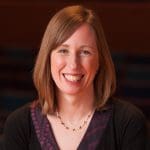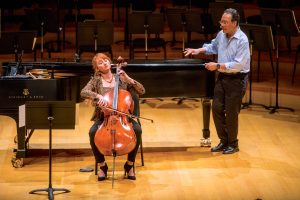AT A CROSSROADS: Conservatory finds ideal leader by following one simple rule

When Diane Helfers Petrella was charged with running the UMKC Conservatory, first as interim dean and then, in 2018, as full-time dean, she was so busy juggling the half-dozen crises facing the school that she barely noticed what was, for the public at least, the most newsworthy aspect of the appointment: She was the first woman to head the Conservatory in its entire 110-year history.
At the time, though, she found herself managing a school divided into three buildings scattered about the sprawling campus, slashing 22 percent from the budget, filling some dozen faculty positions with the world’s best talent, and bolstering the school’s Musical Bridges program, which provides free music lessons to youngsters in underserved communities. Then came the big kahunas: saving the UMKC Theatre department by absorbing it into the former Conservatory of Music and Dance, and finessing the public-relations nightmare of watching a much-anticipated downtown facility dissolve into fiscal thin air.

When it finally came to her attention that a woman had never been asked to tackle problems that have dogged the Conservatory for decades, she was taken aback. “I was genuinely shocked,” she said. “That was not even something I was aware of until the information was shared as part of the announcement to the campus and community.”
To be sure, the Conservatory has long included a large number of women, but like most performing-arts schools large and small across America it always had a man at the helm. “Academia has long been a challenging profession for women, for many reasons,” said Diane, who came to UMKC in 2006 as professor of piano and piano pedagogy after holding posts at Oakland University, Texas Wesleyan, the University of North Texas, and the University of Wisconsin-Madison. “I do believe both arts and academic organizations have realized that a lack of diversity in leadership limits perspectives, and they have consciously worked to be more inclusive of under-represented populations when selecting leaders.”

To welcome Diane to the fold, the Conservatory has presented her with some of the biggest challenges it has ever faced. With the addition of the theater department, the student body has swollen to 700 (about 420 undergraduates and 280 graduate students) and the faculty to 120, and in the face of drastic cuts from the State of Missouri (including, most recently, a hiring freeze), the school now faces the challenge of cramming one of the most significant conservatories in the Midwest into absurdly diminutive, outdated facilities.
On the plus side, the Conservatory has determined to move its new building project back to the main campus, which makes sense in light of the addition of theater: which would not have fit into the downtown structure anyway. And in Diane (who moved here with her husband, Nick, currently UMKC’s coordinator of percussion), the school has found someone who both excels in the creative side and actually enjoys the gritty but necessary organizational aspects of the deanship. “When I was practicing piano eight hours a day and doing all these degrees … I never imagined that I’d love to be an administrator someday.”

But the more Diane began to manage people and programs, the more she found that she enjoyed the challenges. “She has the ability to see the fine details but also see how those details fit into a bigger picture,” said Andrew Granade, professor of musicology and associate dean of academic and faculty affairs, who happened to be on the search team that hired Diane for her initial dual position. “She has an analytical mind, and can take a problem and see what is the core of the problem and how to fix it: and how that will fit into the other things that are going on. … She enjoys the puzzling-out of those solutions.”
Growing up in Buffalo Grove, Illinois, in the northwestern suburbs of Chicago, Diane didn’t immediately dream of a career in music but her family happened on a terrific piano teacher who energized her to advance with celerity. While double-majoring in music and elementary education at Eastern Illinois University, she practiced piano diligently but also became sensitive to effective ways of teaching music to young people. (It will come as no surprise that there is musical talent among the Petrellas’ five children.)

Her dual preparation in pedagogy and performance and her commitment to contemporary music (not to mention her amazingly charismatic personality) have helped build an ideal foundation for growth at the Conservatory. “As I started doing these administrative jobs I realized that, truthfully, there are a lot of people who play the piano really well, but there are relatively few people who … also have the administrative skills.”
Diane’s biggest job at UMKC is not necessarily to make the world aware of the Conservatory (because it already is, to an extent that would surprise many Kansas Citians), but to engender local awareness of how critical the school is to our local arts economy. Because in addition to a world-class faculty that boasts the likes of composer Chen Yi (who was recently named to the American Academy of Arts and Letters), Alon Goldstein (one of the most famous pianists in the world), and Bobby Watson (a widely acclaimed jazz saxophonist who is the school’s director of jazz studies), UMKC has exerted an enormous force for local growth.

“The Conservatory has generated most of the major performing-arts organizations in town,” Diane said, pointing to the Kansas City Ballet, the Kansas City Repertory Theatre, the Kansas City Symphony, and the Kansas City Chorale. “They were all founded by our alumni and faculty. We bring super-talented people to Kansas City … and have engendered a creative workforce that has helped build these wonderful companies, which are the staple of our arts scene.”
The Conservatory is not just training people for high-profile jobs elsewhere: It’s teaching students who will soon be a part of our lives, deeply embedded in our cultural landscape. “Those dancers are the same ones who are teaching your kids ballet,” Diane said. “The singers are the ones that are directing your church choirs, or teaching your kids at public schools.”
Meanwhile she is “doing what I have control over” with respect to facilities. While the world waits out COVID-19, Diane and the Conservatory are engaging in a “space study” to maximize existing structures. “We are bursting at the seams,” Andrew said, adding that one of the challenges of adding theater to the mix is in “forging a single unified Conservatory that has a vision we’re moving on together.”

At the same time, he added, this is an exciting prospect. “With theater now a part of the Conservatory, the types of collaborations we will be able to do are almost limitless.” And someday, he hopes, “instead of having to walk halfway across campus, you can just walk down the hallway and say, Hey, I have this great idea.”
Nevertheless, as needful as the school is for a new facility, it cannot afford to present another architectural plan that is going to be shot down. “This has been going on for 20 years,” Diane said. “We have to get it right. And although no new announcement is imminent, she said, “we are working with Helix Architecture and have consulted with them on potential designs for a new facility on campus.”
—By Paul Horsley
Cover Photo by James Allison
For more information about the Conservatory, its programs, and its faculty, go to conservatory.umkc.edu.
To reach Paul Horsley, performing arts editor; send an email to paul@kcindependent.com or find him on Facebook (paul.horsley.501) or Twitter (@phorsleycritic).





